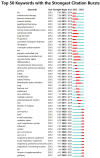Bibliometric analysis of the global research status and trends of the association between Vitamin D and infections from 2001 to 2021
- PMID: 35991038
- PMCID: PMC9386288
- DOI: 10.3389/fpubh.2022.934106
Bibliometric analysis of the global research status and trends of the association between Vitamin D and infections from 2001 to 2021
Abstract
Objective: The objective of this study was the visualization of hot spots and evolving trends in research on the association between vitamin D and infections through the use of bibliometric analysis.
Methods: Based on 3046 relevant articles collected in the Web of Science Core Collection for the period of 2001-2021, the data were processed using CiteSpace software. GraphPad software was used for some of the graphics.
Results: A total of 3,046 literature were retrieved, with an average citation frequency of 27.89 times. The number of published papers in the direction of "Immunology" (453 articles, 14.9%) and "Infectious diseases" (312 articles, 10.2%) is much higher. The United States presents the highest publication count (890, 29.2%) and shows a strong leadership in this field. Country burst shows that since 2015, many developing countries and low-income countries have carried out enthusiastic research in this regard, including China, Pakistan, and Iran. As for institutions, the League of European Research Universities produces a larger proportion of articles (220, 7.2%). In terms of authors, Martineau AR and Camargo CA have the highest number of published articles, contributing 30 (0.99%) and 28 articles (0.92%), respectively. Major studies are supported by the United States Department of Health Human Services funding (394, 12.9%). According to the keyword co-occurrence diagram, the 10 most frequent keywords from 2001 to 2021 are "vitamin D", "infection", "d deficiency", "risk", "association", "expression", "disease", "d supplementation", "vitamin d deficiency", and "children". The top 10 cited articles in 2021 are all related to COVID-19, suggesting it is a hotspot in recent times.
Conclusion: Research on the association between vitamin D and infection has grown rapidly since 2012 and is generally developing well. While developed Western countries continue to be leading roles in this field, research trends in developing countries are also very promising. It is demonstrated that the relationship between vitamin D and respiratory infections, especially respiratory viruses and the more recently COVID-19, has received a lot of attention in the last two decades, suggesting that this is the hotspot and frontier of research issue.
Keywords: hot spots; infectious disease; trends; visualization analysis; vitamin D.
Copyright © 2022 He, Deng and Luo.
Conflict of interest statement
The authors declare that the research was conducted in the absence of any commercial or financial relationships that could be construed as a potential conflict of interest.
Figures






References
Publication types
MeSH terms
Substances
LinkOut - more resources
Full Text Sources
Medical
Research Materials

